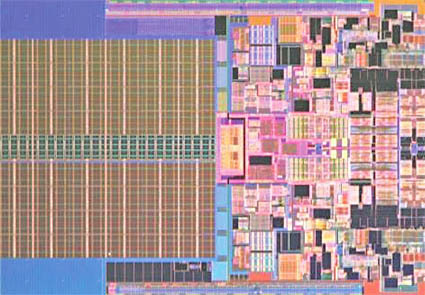Intel preps five 45 nm dual- and quad-core processors
Santa Clara (CA) - Intel shows off its tech horsepower, revealing more details about its upcoming 45 nm CPU generation: Penryn, a processor core that will replace the current 65 nm Core 2 processors, uses a new transistor technology to boost performance and reduce power consumption. The Penryn quad-core will carry a stunning 820 million transistors.
If you are trying to stay somewhat up to date with current computer technologies and run an Intel-based system, then you probably have updated recently to one of the firm's 65 nm offerings. But, at least for early adopters, this is old news, as the 45 nm generation is approaching quickly and we are not talking about some research product here anymore. 45 nm is a real technology.
One year ago, Intel announced the production of a 45 nm SRAM chip, a technology that is commonly used as a prototype platform for a new production process. Now, the company has produced the first 45 nm processors, code-named "Penryn" and claims that the chip is booting every popular operating system including the usual suspects Windows XP/Vista, MacOS and Linux.
The company told journalists on Friday that Penryn essentially will succeed the 65 nm Core 2 Duo (65 nm) Merom core, spinning off into mobile, desktop and volume server CPU derivates, just like its predecessor.
Penryn is not an entirely new processor, meaning that it will continue to use the architectural concept of Merom. While Intel said that Penryn will come with some architecture enhancements such as increased L2 cache size as well as Streaming SIMD4 (SSE4) extensions to speed up media applications, the other change relates to an increased clock speed and some thermal improvements.
410 million transistors and 6 MB L2 cache: The 45 nm Penryn processor core
On the surface, the 45 nm process allowed Intel to cut the space requirement of transistors roughly in half. A dual-core Penryn processor holds 410 million transistors, up from 293 million in Merom/Conroe/Woodcrest. Since Intel did not double the transistor count, it found additional space available on the (original Merom) die, which the company used to increase the L2 cache (on Penryn). While specifications were not revealed, sources told TG Daily that Penryn will integrate 6 MB L2 cache, up from 4 MB today.
Get Tom's Hardware's best news and in-depth reviews, straight to your inbox.
A quad-core Penryn processor, which will be available in desktop and server flavors, will carry 820 million transistors, about half the transistor count of the current Itanium 2 processor with Montecito core. However, this is about 20 times the number of the transistors used in the first Pentium 4 processor with Willamette core, which was released as a 180 nm chip in 2000 (with 42 million transistors).
Intel will not counter AMD's approach to create a native, single-chip quad-core processor and continue to produce the quad-core Penryn in a dual-die, multi-chip package instead. Intel representatives told us that the company sees little reason to transition to a single-die solution at this time, as its current multi-chip approach with Kentsfield and Clovertown is successful and is achieving high yields. Using a multi-die solution, Intel is able to be more selective about the dies for quad-cores. Single-die quad-cores are not expected to arrive until the introduction of the Nehalem core, which will succeed Penryn with a completely new 45 nm architecture in the second half of 2008.
Tom's Hardware is the leading destination for hardcore computer enthusiasts. We cover everything from processors to 3D printers, single-board computers, SSDs and high-end gaming rigs, empowering readers to make the most of the tech they love, keep up on the latest developments and buy the right gear. Our staff has more than 100 years of combined experience covering news, solving tech problems and reviewing components and systems.


